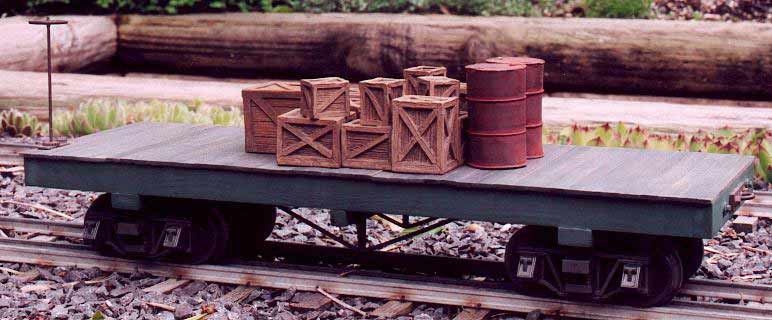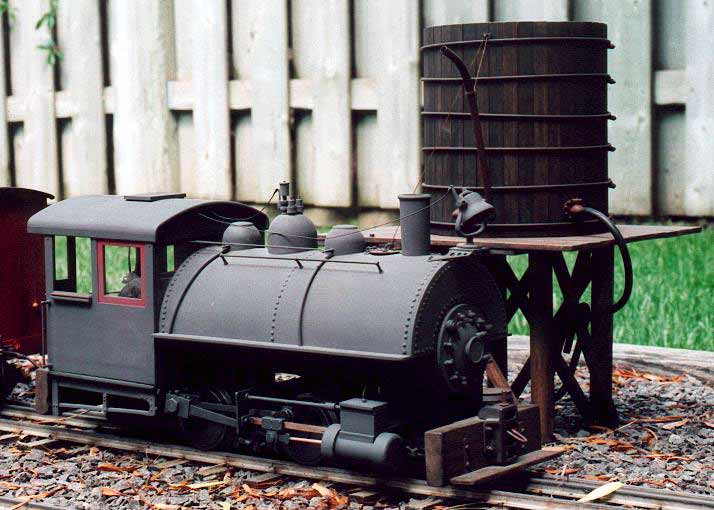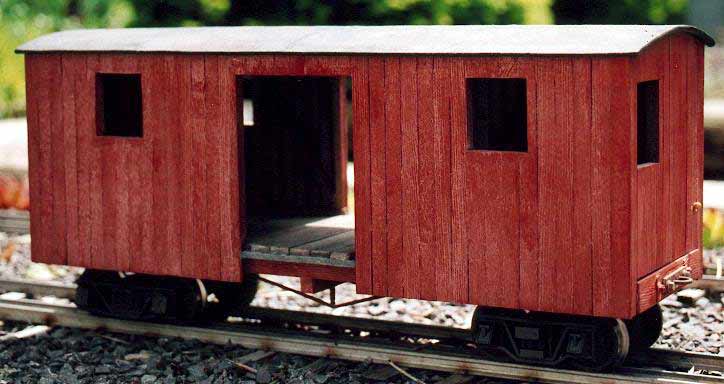 I
have long been a fan of the Huntsville and Lake of Bays Railway,
since the time I first saw pictures of it Omer Lavallee's book
"Narrow Gauge Railways of Canada". The Huntsville and
Lake of Bays Railway was a mere mile and an eighth in length.
Built in 1905, the railway served to carry passengers and freight
between steamboat routes in the resort area of the province of
Ontario, a few hours by train north of Toronto. The passenger
train was nicknamed the "The Portage Flyer" and ran
to steamboat schedule, carrying passengers over the portage twice
a day in either direction between two lakes. Between these trains,
the railway hauled tanbark (used the tanning of leather), freight
and supplies for the resorts. The railway was unique in the fact
that it had two gauges during it's 62-year life. The railway
was a classic narrow gauge line in the fact that it had either
used or home built equipment. Initially the locomotive fleet
was two 8-ton Porter 0-4-0s, which operated doubled headed, then
in the later years, larger 0-4-0 saddletank engines. In terms
of rolling stock, it had two passenger cars (former trolley cars),
two home built box cars (for express and baggage) and a few flat
cars for everything else.The latter two locomotives and passenger
cars reside today in Huntsville, Ontario and form the basis of
a tourist railway operated by the Huntsville and Lake of Bays
Railway Historical Society. More information on the operation
can be found at: www.portageflyer.org. A full list of sources of information on the
railway can be found here.
I
have long been a fan of the Huntsville and Lake of Bays Railway,
since the time I first saw pictures of it Omer Lavallee's book
"Narrow Gauge Railways of Canada". The Huntsville and
Lake of Bays Railway was a mere mile and an eighth in length.
Built in 1905, the railway served to carry passengers and freight
between steamboat routes in the resort area of the province of
Ontario, a few hours by train north of Toronto. The passenger
train was nicknamed the "The Portage Flyer" and ran
to steamboat schedule, carrying passengers over the portage twice
a day in either direction between two lakes. Between these trains,
the railway hauled tanbark (used the tanning of leather), freight
and supplies for the resorts. The railway was unique in the fact
that it had two gauges during it's 62-year life. The railway
was a classic narrow gauge line in the fact that it had either
used or home built equipment. Initially the locomotive fleet
was two 8-ton Porter 0-4-0s, which operated doubled headed, then
in the later years, larger 0-4-0 saddletank engines. In terms
of rolling stock, it had two passenger cars (former trolley cars),
two home built box cars (for express and baggage) and a few flat
cars for everything else.The latter two locomotives and passenger
cars reside today in Huntsville, Ontario and form the basis of
a tourist railway operated by the Huntsville and Lake of Bays
Railway Historical Society. More information on the operation
can be found at: www.portageflyer.org. A full list of sources of information on the
railway can be found here.
 I
started to model the railway in 1/24th scale about about twenty
years ago. I'll admit that the progress has been slow over the
years, but I still have manage to accomplish a lot of modeling,
with a high degree of scratch building and kit bashing. The railway's
two flat cars were constructed first, using stripwood, commercial
detail castings and Bachmann trucks. Couplers on the Huntsville
and Lake of Bays were interesting, being clevis and pins. I was
able to replicate them in scale with model airplane parts and
pop rivets for the pins. (One of those interesting and gratifying
moments when looking beyond the usual hobby supplies materials
for a suitable source yields the perfect solution.) The second
thing I modeled was the line's water tower, constructed of strip
wood. I decided that it should be more than a mere decoration,
it actually holds water and is used to fill my live steamers
(an old tomato sauce can forms the basis of the tank and an aquarium
air line valve inside controls the water flow to the spout).
I
started to model the railway in 1/24th scale about about twenty
years ago. I'll admit that the progress has been slow over the
years, but I still have manage to accomplish a lot of modeling,
with a high degree of scratch building and kit bashing. The railway's
two flat cars were constructed first, using stripwood, commercial
detail castings and Bachmann trucks. Couplers on the Huntsville
and Lake of Bays were interesting, being clevis and pins. I was
able to replicate them in scale with model airplane parts and
pop rivets for the pins. (One of those interesting and gratifying
moments when looking beyond the usual hobby supplies materials
for a suitable source yields the perfect solution.) The second
thing I modeled was the line's water tower, constructed of strip
wood. I decided that it should be more than a mere decoration,
it actually holds water and is used to fill my live steamers
(an old tomato sauce can forms the basis of the tank and an aquarium
air line valve inside controls the water flow to the spout).



